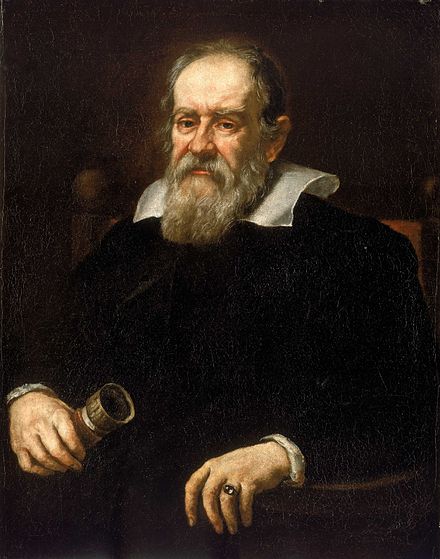
Galileo Galilei
Galileo Galilei (February 15, 1564 to January 8, 1642) Galileo is one of the greatest figures of the Scientific Revolution. His discoveries in astronomy and physics played a central role in creating modern science. In 1609, only a year after the telescope was invented, Galileo constructed his own and started using it to make astronomical observations — the first person to do so. His most famous telescopic discoveries were that Jupiter has moons (the first moons of another planet to be discovered), that Venus has phases, that earth’s own moon has mountains on it, and that there are spots on the sun. Galileo’s discovery of the phases of Venus was crucial, because these showed that sometimes Venus was on the other side of the sun, which contradicted and refuted Ptolemy’s geocentric model of astronomy. Many astronomers therefore adopted a different geocentric model that had been proposed by Tycho Brahe, which was consistent with the phases of Venus and all other observations possible at that time, and which even seemed to have some advantages over Copernicus’s heliocentric model. As a champion of heliocentrism, Galileo “overplayed his hand.” His two proofs of the earth’s motion (based on the tides and on sunspots) were not, in fact, valid. Compelling evidence for the earth’s motion did not come until long after Galileo’s death. Sometimes Galileo was on the wrong side of important scientific disputes (e.g. he rejected Kepler’s theory that the moon’s gravity caused the tides and ignored Kepler’s crucial discovery that planetary orbits are elliptical). Nevertheless, Galileo’s role in astronomy was truly epoch-making. His discoveries in physics were no less important, especially his discovery of the Law of Falling Bodies, which was that all freely falling bodies fall with constant (and equal) acceleration. This was the beginning of experimental physics and helped pave the way for Newton’s theories of mechanics and gravity. Tragically, in 1633, Galileo was forced by Church authorities to renounce his belief in Copernicanism and was sentenced to lifelong house arrest, which he was allowed to serve in his villa in Tuscany, where he was also allowed to receive visitors. It was during his confinement that he finished writing his great treatise on mechanics. Although publishing it violated the terms imposed on him by the Church, the Church authorities decided not to take any action when the book appeared in print, since it did not discuss Copernicanism. The Church still permitted Copernican astronomy to be studied in its scholarly institutions, but only as a mathematical model, not as the physical truth.
The “Galileo affair” was very complex. There were scientists on both sides of the heliocentrism debate and Galileo had many friends and defenders among the clergy and hierarchy. (Even the pope who had him tried had originally been one of Galileo’s patrons and admirers.) The Church’s leading theologian (St. Robert Bellarmine) admitted that if the motion of the earth could be demonstrated by reason, then Scripture would have to be interpreted accordingly. Unfortunately, such demonstrations were not possible at that time and the Church authorities rushed to judgment. While some see the treatment of Galileo as showing the incompatibility between science and religion, Galileo himself did not see it that way. He remained a devout Catholic throughout his life. Like virtually all the great figures of the Scientific Revolution, he saw scientific discoveries as revealing the magnificence of God’s creation. One of his favorite ideas was that God reveals himself in two books, “the Book of Nature” and the Holy Scriptures, and that if properly interpreted these can never be in conflict. This idea came from St. Augustine, who had warned already in the year 400 that we should recognize “the book of nature as the production of the Creator of all, and [believe that our] own finite understanding might be at fault wherever anything” in Scripture seemed to contradict it.
Explore Other Scientists
It is our hope that this curated set of biographies will be useful to teachers, students, and the general public.